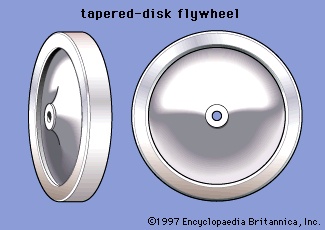flywheel
machine component

 heavy wheel attached to a rotating shaft so as to smooth out delivery of power from a motor to a machine. The inertia of the flywheel opposes and moderates fluctuations in the speed of the engine and stores the excess energy for intermittent use. To oppose speed fluctuations effectively, a flywheel is given a high rotational inertia; i.e., most of its weight is well out from the axis. A wheel with a heavy rim connected to the central hub by spokes or a web (wheel A in the Figure-->
heavy wheel attached to a rotating shaft so as to smooth out delivery of power from a motor to a machine. The inertia of the flywheel opposes and moderates fluctuations in the speed of the engine and stores the excess energy for intermittent use. To oppose speed fluctuations effectively, a flywheel is given a high rotational inertia; i.e., most of its weight is well out from the axis. A wheel with a heavy rim connected to the central hub by spokes or a web (wheel A in the Figure--> ) has a high rotational inertia. Many flywheels used on reciprocating engines to smooth out the flow of power are made in this way. The energy stored in a flywheel, however, depends on both the weight distribution and the rotary speed; if the speed is doubled, the kinetic energy is quadrupled. A rim-type flywheel will burst at a much lower rotary speed than a disk-type wheel of the same weight and diameter. For minimum weight and high energy-storing capacity, a flywheel may be made of high-strength steel and designed as a tapered disk, thick at the centre and thin at the rim (see Figure B-->
) has a high rotational inertia. Many flywheels used on reciprocating engines to smooth out the flow of power are made in this way. The energy stored in a flywheel, however, depends on both the weight distribution and the rotary speed; if the speed is doubled, the kinetic energy is quadrupled. A rim-type flywheel will burst at a much lower rotary speed than a disk-type wheel of the same weight and diameter. For minimum weight and high energy-storing capacity, a flywheel may be made of high-strength steel and designed as a tapered disk, thick at the centre and thin at the rim (see Figure B--> ).
).In automobile engines the flywheel serves to smooth out the pulses of energy provided by the combustion in the cylinders and to provide energy for the compression stroke of the pistons. The larger the rotational inertia of the flywheel, the smaller the changes in speed resulting from the intermittent power supply and demand.
In power presses the actual punching, shearing, and forming are done in only a fraction of the operating cycle. During the longer, nonactive period, the speed of the flywheel is built up slowly by a comparatively low-powered motor. When the press is operating, most of the required energy is provided by the flywheel.
- Maskin, Eric S.
- Maslow, Abraham H.
- masnawi
- masochism
- Maso di Banco
- Maso Finiguerra
- Masolino
- Mason
- Mason and Dixon Line
- Mason, Bobbie Ann
- Mason, Charlotte
- Mason City
- Mason, Daniel Gregory
- Mason, George
- Mason, James
- Mason, James Murray
- Mason, John Mitchell
- Mason Locke Weems
- Mason, Lowell
- Mason, Max
- masonry
- Mason ware
- Masoretic text
- Maspero, Gaston
- masque